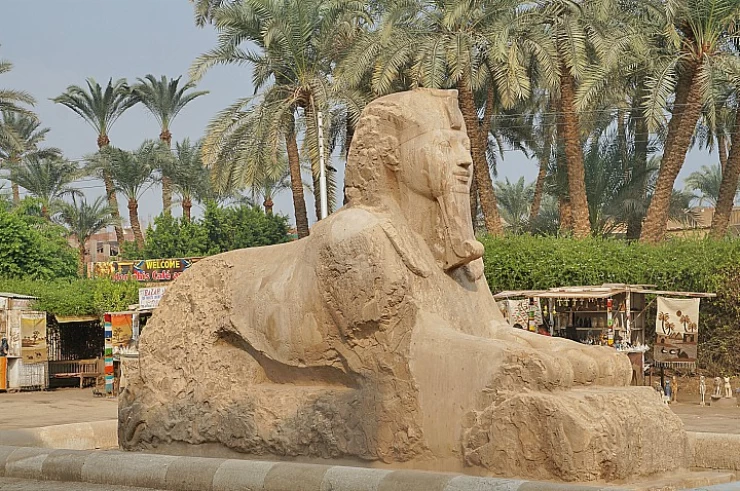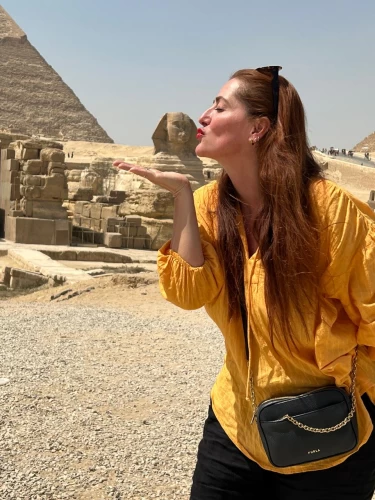
The Red Pyramid
The Red Pyramid: A Fascinating Architectural Work Buried Under Egypt
The Red Pyramid not only solely emphasizes its reddish hue, which is the reason why it was given the Red Pyramid tag. It was also the first correctly built, smooth-sided pyramid instead of its predecessor stepped pyramids, which marked a great achievement in ancient Egyptian architecture, and most importantly, the Pyramid, which all aforementioned pylons were built following.
Historical Background: Sneferu's Architectural Legacy
The construction of the Red Pyramid is dated 2613–2589 BC, when Pharaoh Sneferu ruled over Egypt. This ruler is known in history for having built more pyramids than any other pharaoh of Egypt. The desire to build a perfect pyramid is seen in his other two major pyramid-building endeavors: the Meidum Pyramid and the Bent Pyramid. These two earlier ones, however, encountered some structural problems, with Meidum collapsing at some point in time while the Bent had to undergo a design change at some point as it was not stable.
The Red Pyramid, also known as the Northern Pyramid, resides in the Dahshur necropolis, situated 40 kilometers south of Cairo, where it also presents a more delicate tower-like shape as compared to the rest of the pyramids built before it. The construction of the Red Pyramid was remarkably smooth, thanks to advanced technology and lessons learned from previous projects, thus making it the first pyramid in history designed geometrically to be devoid of irregular surfaces. This will play a big part in his son Khufu constructing the Great Pyramid of Giza, which is one of the Seven Wonders of the Ancient World.
The Unique Design and Construction
The Red Pyramid, ascending to a height of 104 meters (341 feet) above sea level, is the third tallest pyramid in Egypt after the Great Pyramid of Giza and the Pyramid of Khafre. It was originally a little taller than its present height, but similarly to a lot of ancient Egyptian structures, the outer casing stones were taken away as the years went by, hence the reduction in height.
Easily, one of the most outstanding elements of the architecture of the Red Pyramid is the fact it has smooth sides, which is different from the traditional pyramids that had steps of rising blocks. The slope of the pyramid, however, is a shallow angle of 43 degrees, which made it quite stable; this is because, after the experience with the inclined Bent Pyramid, which had an unsafe 54-degree slope until a third of the way up when they changed it, they understood that too much incline was not safe.
The term “Red Pyramid” is derived from the color of the local limestone used in the construction of the pyramid. Curiously, the pyramid was first covered with polished white Tura limestone that would have made it glitter in the sun. The majority of this outer casing was peeled off over the ages, letting out the reddish core inside. In present times, some of the white casing stones at the base can still be found in the present, showing the visitors how the pyramid was originally constructed.
The enormous size and smooth, sharp corners of the Red Pyramid are proof of the brilliance of Pharaoh Sneferu’s ancient Egyptian architects and their resolve to develop the construction of pyramids to the highest level.
Exploring the Interior: A Journey Back in Time
The Red Pyramid, unlike most of the popularly known pyramids of Egypt, allows visitors to go inside, and it is one of the most exciting things to do in Egypt to get into it. The pyramid rests on a passage that snakes its way for quite a distance of 62 meters and leads downwards at an angle of about 27 meters underground.
After completing this passage, the visitors come across the first of the three burial chambers, all with corbel ceilings applied to help avoid crushing the structure by distributing the weight. The temples are magnificent, with cylindrical roofs stretching upwards of 12 meters (40 feet), giving an incredible opening and appreciating the skill of construction that dates back ages.
Without a doubt, the pyramid’s interiors are devoid of carvings or pictorial depictions; however, the grandeur and the feeling of antiquity still stand in great clarity. The red pyramid was however largely believed to be meant for the king’s burials, but it’s mentioned that his body has never been found inside the correct place, hence some history of this pyramid is ambiguous.
The Engineering Genius Behind the Red Pyramid
The Red Pyramid is a landmark construction in the history of ancient Egyptian architecture. After the architect, Sneferu tried to build the Meidum Pyramid but failed, and after the bending of walls in the Bent Pyramid, the skilled builders were able to apply the construction methods that ensured that the Red Pyramid could withstand the test of time for thousands of years.
The composite nature of this pyramid contributes to its success. First, the angle of the pyramid, which is not steep so much, lessens the chances of it falling, making it more stable than the bent pyramid. In the burial chambers, corbelled ceilings were also used to make sure that the ceilings in the inside structure could hold up the great mass of the pyramid, even that of the internal structures. Also, the placement of the stones, some weighing up to a few tons, clearly shows that the ancient civilization of Egypt had a great comprehension of science and could apply it in the structural engineering of the pyramids.
The construction of the Red Pyramid also involved advanced quarrying techniques, with limestone being procured from closer quarries and an extensive workforce used to move and place the stones. While the majority of them are believed to have been recruited laborers, these workers were capable of an extraordinary level of accuracy in the placement and fitting of the blocks to form the pyramid.
The structure sits in pride, displaying the creativity and ambition of Egypt. It is a clear understanding that the pyramids were not only burial places but also an escape of architectural marvels in mankind's journey.
A Hidden Gem for Travelers
In sharp contrast to the lively and heavily visited Giza pyramids, the Red Pyramid welcomes its visitors in a calm and personal way. Being in the Dahshur Necropolis, a zone where there are relatively few visitors, makes it a treasure for those who wish to appreciate the ancient history of Egypt more peacefully.
Both climbing into the pyramid and walking through its narrow, dark corridors and entering inside the vast burial rooms are completely different experiences as compared to the interior of the Great Pyramid of Giza, which is often filled with tourists and under strict security. The Red Pyramid is more conducive for those interested in looking at the ancient civilization, especially since it has not been changed or corrupted.
The Red Pyramid is also in great demand among professional photographers because of its bright red limestone walls set against the brilliant blue sky and the golden desert sands. Visitors can also climb a short way up the side of the pyramid, which presents a view of the Dahshur necropolis that includes the Bent Pyramid and a few other tombs and structures.
The Dahshur Necropolis: A Window into Ancient Egypt
The Red Pyramid is located in Dahshour, a conic burial ground for royal figures of the Old Kingdom and other structures. Besides the Red Pyramid, the other pyramid built by Sneferu in Dahshur is the Bent Pyramid, noted for its distinct structure with an angle that altered about halfway through construction. Besides the pyramids themselves, visitors going to Dahshur can also visit other ancient remains, including the smaller pyramids and mastabas, which hint at the activities of the pre-Egyptian dynastic period.
Dahshur being less developed and commercialized is unlikely to appeal to many tourists but is ideal for architectural enthusiasts in the vacationing period. It is a place both for history lovers and daring explorers; one can visit the pyramids and the tombs without the annoying presence of tourists that abound in the other popular tourist locations.
Conclusion: The Red Pyramid’s Enduring Legacy
While the Red Pyramid of Sneferu may not be as popular as the pyramids in Giza, the role it plays in ancient Egyptian architecture cannot be downplayed. As much as it is the first pyramid to have a smooth outline, it is also the apex of architectural creativity and innovations gone several steps back.
Whether it is the tourists or the historians, The Red Pyramid provides an extraordinary opportunity to appreciate the remarkable creativity of ancient Egyptian builders, as well as the legacy of pharaoh Sneferu. Its tranquil environment and the stunning shape of the structure make it more of a hidden jewel rather than a wreck of a Megalith statue that Egypt still has for those looking to peel off the thick coats of rich history.
If you are fascinated by the discoveries in old engineering, the enigma of the pyramids, or wish to just have a different kind of thrill, the Red Pyramid brings the story back to one of the interesting periods of construction in Egypt. On one hand, it is hard to miss the influence of an astonishing ancient world that is thousands of years old and still evokes a sense of awe from within the viewer’s experience, particularly with the vast desert and the Red Pyramid up above.
Latest Articles
Admin
Seabourn Sojourn Cruise Stops in Safaga Port
The Seabourn Sojourn, the flagship vessel of Seabourn Cruise Line's ultra-luxury fleet, was built in 2008 at the T. Mariotti shipyard in Genoa, Italy. Measuring 198 metres, it can accommodate up to 450 guests in its 225 spacious all-suite staterooms.
Admin
Norwegian Sky Cruise Stops in Safaga Port
Norwegian Cruise Line operates a cruise ship called the Norwegian Sky. It was constructed in 1999 and can accommodate 2,004 passengers in addition to 878 crew members. The ship has several dining establishments, lounges and bars, a spa and fitness center, swimming pools, and a number of entertainment areas.
Admin
Explora II Cruise Stops in Safaga Port
Explora II, the second vessel in the Explora Journeys fleet, sets sail in 2024 to redefine luxury cruising. With 461 ocean-front suites, 9 culinary experiences, and 4 pools, this haven of sophistication and sustainability promises an unforgettable "Ocean State of Mind" journey to inspiring destinations.
Admin
Mein Schiff 6 Cruise Stops in Safaga Port
The Mein Schiff 6 is the latest cruise ship in the renowned TUI Cruises fleet, offering passengers a luxurious and sophisticated cruise experience. At 315 metres long, this floating resort features a range of dining options, entertainment, and recreational facilities, including a spa, fitness centre, and sports amenities.
Admin
Mein Schiff 4 Cruise Stops in Safaga Port
When the Mein Schiff 4 cruise ship docks in Safaga, Egypt, passengers are granted access to a realm of ancient wonders. Aboard this state-of-the-art vessel, guests can embark on meticulously curated shore excursions that showcase the region's most iconic landmarks, including the Giza Pyramids, the enigmatic Sphinx, and the remarkable tombs and temples of the Valley of the Kings in Luxor.
Admin
MS Europa Cruise Stops in Safaga Port
The Silver Moon, Silversea's latest flagship, is a luxury cruise ship that offers an exceptional travel experience for Venezuelans exploring Egypt. With a capacity of 596 guests and an impressive 40,700 gross tonnes, the Silver Moon maintains the small-ship intimacy and spacious all-suite accommodations that are the hallmarks of the Silversea brand.

























